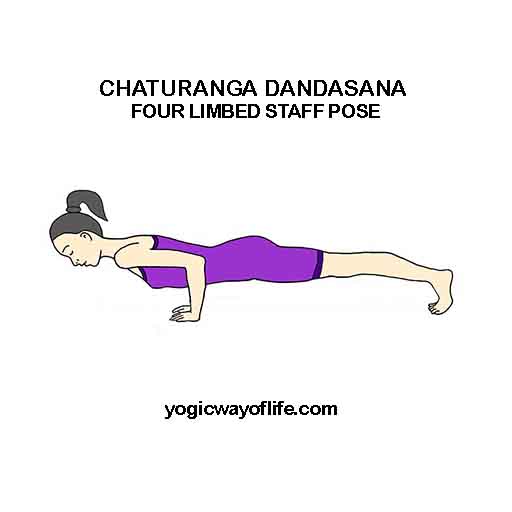Chaturanga Dandasana or Four Limbed Staff Pose is a basic pose to bring balance and strength to arms and legs. In sanskrit, Chatur means four and Anga means part (of the body). Danda means the staff and asana means the pose. It is also known as the Low Plank Pose. In the final pose, the entire weight of the body is distributed on the palms and the toes.
How to do Chaturanga Dandasana (Four Limbed Staff Pose)?
- Start with Vajrasana or the kneeling position.
- Now, raise the buttocks up and bend forward, placing your palms on the floor in front of you.
- The palms should be spaced at shoulder length and the hands should be straight. The knees and lower legs are rested on the floor.
- Now, take your legs back with the legs supported on the toes.
- This is the high plank pose where the knees are above the ground and you are supported by the palms and the toes.
- From the high plank pose lower the knees to the ground and bend the elbows bringing the torso closer to the floor. At this point the two hands are on the sides, elbows bend and the chest above the ground.
- Raise your knees above the floor, so that the body is in a straight line, horizontal to the ground. The entire weight of the body is resting on the palms and the toes.
- This is the final pose. Try to remain in this position for as long as you are comfortable.
- To release the position, make the hands straight and lower the knees to the ground to come to the high plank pose.
- Then bend the knees and bring back the buttocks to the kneeling position.
Benefits of Chaturanga Dandasana (Four Limbed Staff Pose)
- Chaturanga Dandasana strengthens the wrists, arms, muscles of the legs, hips and shoulders.
- It is a good balancing pose for beginners.
- It strengthens the muscles around the spine.
- This pose is used in Surya Namsakara or the sun salutation. It is achieved before doing the Ashtanga Namaskara pose in the Sun Salutation.
- It strengthens the toes as substantial part of the body weight is supported by the toes.
To avoid the common mistakes in this pose, make sure that your chest does not sag down or touch the ground. The entire body should be straight like a plank and parallel to the ground.

